As you can see, many of the tennis stringing machines on this list are by Gamma. There’s a good reason for that, as the company offers more than 12 individual stringing machines. They offer units with various price tags and feature sets, making the brand a popular choice amongst tennis pros. Many players are also familiar with Gamma’s racquets, grips, strings, and vibration dampeners.
Gamma Sports Racquet Stringing Machines – X basic Series
The X Series of stringing machines includes four models: The X-2, X-ST, X-6, and X-6FC. All four boast a table-top design and are easily portable.
X-2
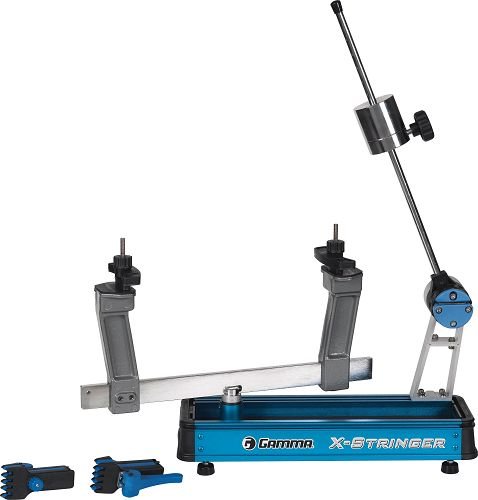
The X-2 stringing machine comes with a drop weight tensioning setting, so it takes a little longer to set up and use than the other options. It can set the string tension between 9 and 90 pounds, so it’s guaranteed to suit your racquet.
This affordable model has two points of contact on the frame, meaning it could twist the racquet slightly whilst you’re stringing it. It also uses floating clamps, which aren’t as good as fixed clamps when it comes to maintaining tension on the strings. That being said, the unit is ideal for beginners who want an affordable tennis stringing machine.
X-6
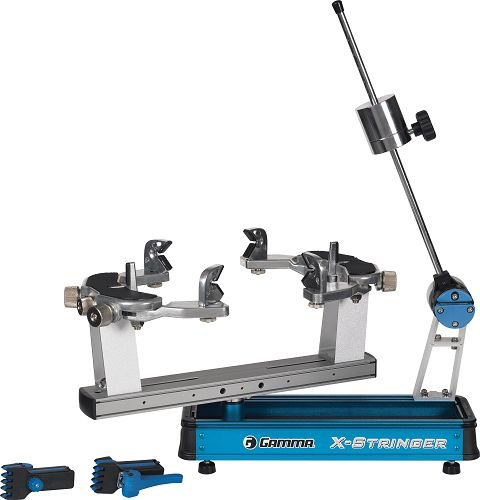
The X-6 stringing machine is a step up from the X-2, which is reflected in the price tag. The unit also has a drop weight design that creates between 9 and 90 pounds of tension. However, it provides six contact points on the racquet while the X-2 only has two. This enables more accurate tensioning and reduces the risk of distorting the frame during the process.
X-6FC
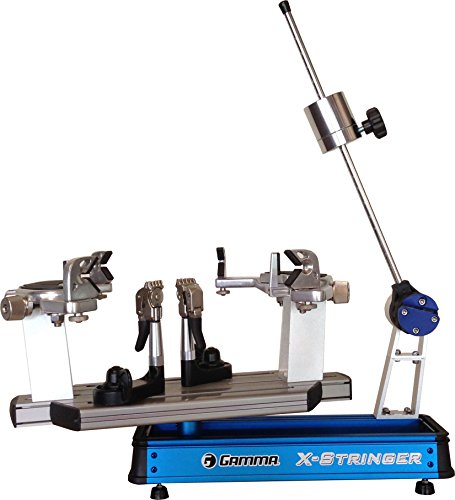
If you’re looking for a stringing machine that can string other types of racquets, you may prefer the X-6FC. This unit benefits from fixed clamps that provide enough tension for other types of racquets, including badminton racquets. Apart from this, the model is identical to the X-6.
X-ST
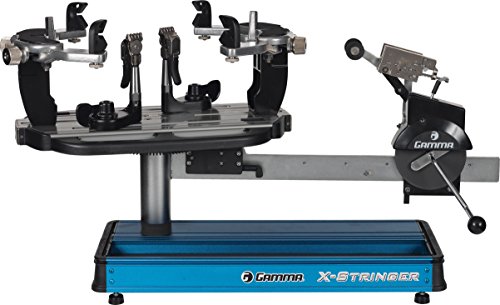
The X-ST stringing machine is the top model in the X Series of tennis stringing machines. The unit benefits from a manual stringing process, which sets it apart from the others in the series. Although the manual system requires physical effort, it’s able to achieve a more precise level of tension than a drop weight system. Like the X-6 machines, the X-ST boasts six contact points on the racquet frame.
All the units in the X Series come with the tools you’ll need to string a racquet, including a hex wrench set, awls, and two pliers. The machines also come with a draw in the base, which is handy for storage purposes. You’ll be able to store your tools with the machine and have them with you at all times, even if you transport the unit to a client, friend, or tournament.
If you’re hoping to perform stringing in a tennis pro shop or as a side business, you may be better off with the top-of-the-range Gamma X-ELS. This unit boasts an electronic system to make the stringing process easier than ever.
However, the features of the basic X-series models will be fine for those looking to restring their own racquet. They’re all easy to use and generate precise tension, and some even work with several different racquets.
Prince NEOS 1000 Stringing Machine
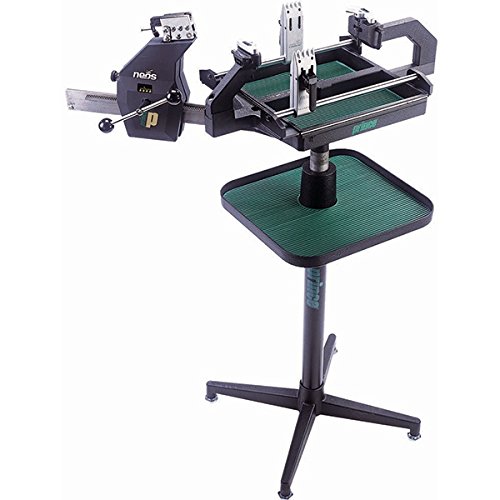
If you’re after an advanced tennis stringing machine, you can’t go wrong with the Prince NEOS 100 Stringing Machine. Despite being over 20 years old, the model remains a favorite of tennis professionals. In fact, many tennis pro shops use this unit to perform the restringing process.
Prince upgraded this model a few years back with the NEOS 1500. However, the company has vowed to continue making the NEOS 1000 and its parts for customers who prefer the original design.
As the NEOS 1000 uses a manual tension design, it requires a bit of physical strength to use effectively. However, it’s able to achieve more accurate tension settings than drop weight and electronic units, so it’s certainly worth the effort. The machine also comes with two contact points on the racquet frame.
The NEOS 1000 is a standalone tennis stringing machine. This means that it’s less portable than the tabletop models but allows you to work at a height that’s suitable for you. This is ideal if you’re restringing a large number of racquets, as tabletop units can become uncomfortable when used for a long duration.
If you want to invest in an advanced stringing machine or you want to upgrade your basic unit, the Prince NEOS 1000 is a great option.
Tips for Stringing a Racquet
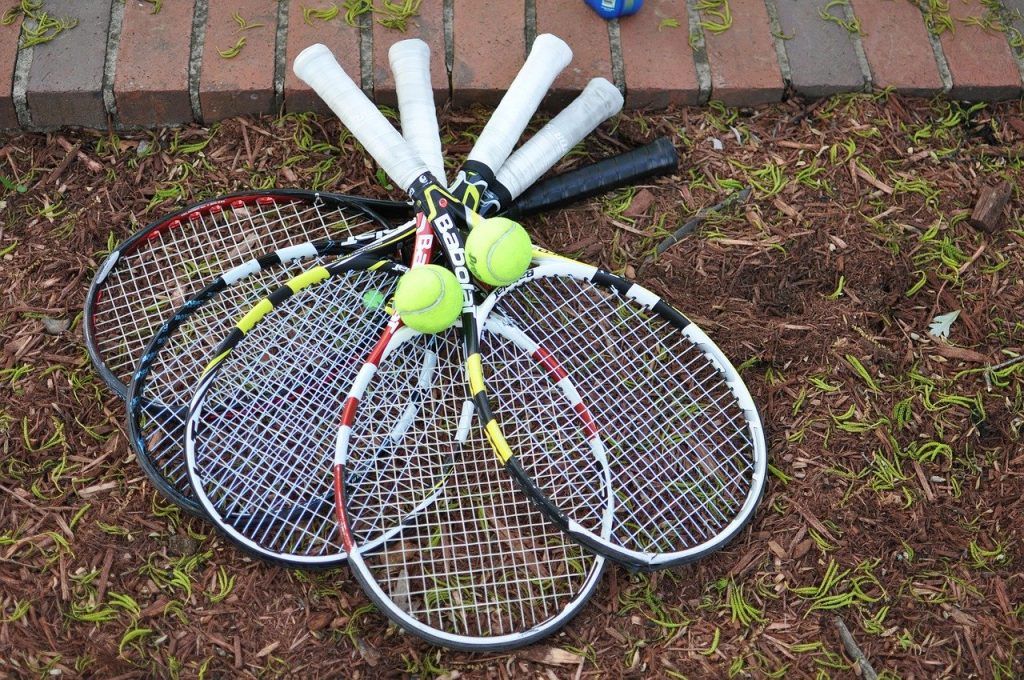
When to Restring
To avoid breaking a string in the middle of the tournament, restring your racquet regularly. In terms of when to restring it, the rule of thumb says if you play four times per week, you’ll want to restring your racquet four times per year. If you play tennis twice per week, you’ll only need to restring twice.
If you’re a serious tennis athlete, however, you may want to restring more often. Get to know your racquet and restring whenever you feel it’s necessary.
Understanding String Tension
The tension on a tennis string is measured in pounds. It is equal to the amount of pressure placed on a particular string when the machine pulls it. Typically, racquets with a lower string tension provide more power on the court. Strings with less tension allow the ball to bounce back with more power, acting as a trampoline.
Racquets with a higher string tension provide more control on the court by using spins. To figure out the maximum and minimum tensions of your racquet, look for a string tension range printed on the side.
Types of Tennis Strings
There are four types of tennis strings: natural gut, nylon, polyester, and Kevlar.
Synthetic strings are the most affordable, while natural gut is the priciest.
Each type of string has a different feel, so it’s worth testing them out to decide which fits your game. Typically, lower-priced strings work better for beginners and intermediate players who tend to mishit. If your shots are more precise, you’ll be best with natural gut. However, natural gut won’t last as long as synthetic strings.
Things to Consider in Tennis Stringing Machine
Your Usage
Before choosing a tennis stringing machine, think about how often you’ll be using it. If you’re only stringing your personal racquets when needed, you’ll require fewer features and may be fine with a budget-priced machine. If you’re planning to string several racquets, you’ll probably need to invest in a machine with more features.
Tension Setting Process
Stringing machines come with three tension settings processes. Each process requires a different level of effort to set the tension and comes with a different cost structure.
Manual machines, or crank machines as they’re sometimes called, required a high level of physical effort. However, they’re accurate and inexpensive.
A drop weight machine is also affordable and easy to use. It requires less effort than a manual machine but takes longer to string the racquet.
The most expensive stringing machines are electronic models, as they use a computer chip to measure the tension. Some electronic machines use a manual hand crank, while others use a motor to set the tension. The latter requires no physical effort what so ever.
Mounting System
The mounting systems used in tennis stringing machines vary. Each system contains a different number of contact points that hold the frame during the stringing process.
The least expensive machines are those with two points of contact. These will also string the racquet quickly. However, the frame can occasionally become twisted during the stringing process.
Machines with four or six contact points are more expensive and take longer to string the racquet; however, the frame will remain stable during the process and has less chance of being damaged.
String Clamps
Tennis stringing machines come with different types of clamps. A fixed clamp provides better consistency in the tension of the string than a floating clamp. However, fixed clamp machines are typically more expensive.
Size
Tennis stringing machines come in two different sizes: tabletop and standalone. If you’re planning to take the machine to a client or tournament, choose a unit that fits on a tabletop.
The other option is a standalone stringing machine. Standalone machines are less portable than tabletop versions but often include more advanced features. Typically, tabletop units are more affordable than standalone machines.
So, there you have it – the best tennis stringing machines. For best results, restring your tennis racquet regularly. As we mentioned earlier, one rule of thumb says that if you play tennis twice a week, you should restring your racquet at least twice a year. If you play tennis 5 times a week, restring your racquet 5 times per year.
Although tennis stringing machines are an investment, they pay for themselves within a few months – particularly if you need to restring your racquet regularly. If you’re new to tennis, get started with a basic model and upgrade if necessary. If you’re a tennis pro, you may want to invest in a state-of-the-art machine from the start.
Whether you’re a seasoned tennis athlete or a complete beginner, restring your racquet regularly to get the most from your game. With a tennis stringing machine, the restringing process is easier than ever. Before investing, weigh up the units above and decide which one suits you best.